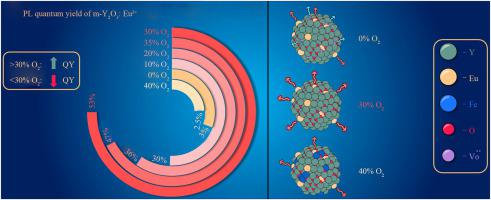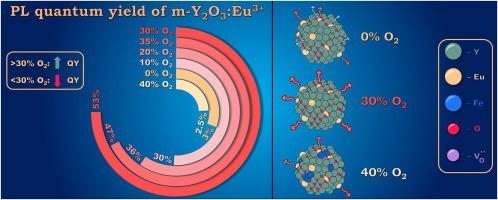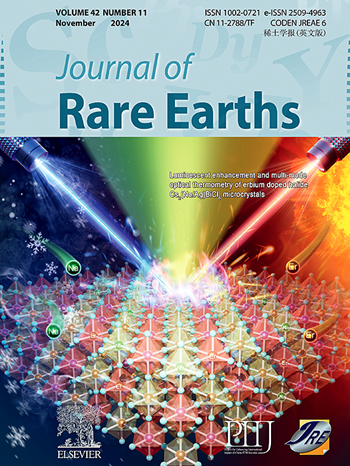Creation of an oxygen-enriched environment during synthesis as an effective way to improve luminescent properties of Y2O3:Eu3+
IF 7.2
1区 化学
Q1 CHEMISTRY, APPLIED
引用次数: 0
Abstract
The growing demand for luminescent nanomaterials intended for various applications increases the necessity to develop and improve approaches to the creation of highly efficient nanosized phosphors. In current study, an approach to enhancing the efficiency of red luminescence of monoclinic Y2O3:Eu3+ with the particle size of ∼20 nm by creating the oxygen-enriched environment during the gas-phase synthesis was developed. To investigate the effect of oxygen amount during the synthesis on characteristics of the phosphor, a series of nanostructured Y2O3:Eu3+ with the addition of 0–40 vol% O2 to the main buffer gas Ar was synthesized by laser vaporization. It is shown that the amount of added O2 exerts virtually no effect on the phase composition and particle size, but significantly improves the luminescent characteristics of Y2O3:Eu3+. Thus, the addition of 30 vol% O2 leads to virtually a 20-fold growth in the photoluminescence (PL) intensity caused by 5D0→7F0–4 transitions in Eu3+ and an increase in the absolute PL quantum yield from 3% to 53% (λex = 395 nm) compared to the sample synthesized without O2. The addition of oxygen also improves the emission color coordinates from (0.571, 0.320) to (0.630, 0.322) due to the removal of a considerable fraction of oxygen vacancies. The synthesized nanopowders are shown to be highly stable: upon storage under ambient conditions for two years. Quantum yield (QY) of the samples decreases by less than 2%. It is expected that the key features underlying the proposed approach will be useful for various methods used to synthesize oxide nanophosphors.


在合成过程中创造富氧环境是改善 Y2O3:Eu3+☆ 发光特性的有效方法
随着各种应用领域对发光纳米材料需求的不断增长,开发和改进高效纳米荧光粉的方法变得越来越有必要。本研究开发了一种方法,通过在气相合成过程中创造富氧环境来提高粒径为 20 纳米的单斜 Y2O3:Eu3+ 的红色发光效率。为了研究合成过程中氧气量对荧光粉特性的影响,采用激光气化法合成了一系列在主缓冲气体 Ar 中加入 0-40 vol% O2 的纳米结构 Y2O3:Eu3+。结果表明,O2 的添加量对相组成和粒度几乎没有影响,但却能显著改善 Y2O3:Eu3+ 的发光特性。因此,与不添加氧气的合成样品相比,添加 30 Vol% 的氧气可使 Eu3+ 中 5D0→7F0-4 转变所产生的光致发光(PL)强度提高 20 倍,PL 绝对量子产率从 3% 提高到 53% (λex = 395 nm)。由于去除了相当一部分氧空位,氧气的加入还改善了发射色坐标,从(0.571, 0.320)变为(0.630, 0.322)。合成的纳米粉体具有很高的稳定性:可在环境条件下储存两年。样品的量子产率(QY)下降不到 2%。预计所提出的方法的主要特点将对用于合成氧化物纳米磷的各种方法有用。
本文章由计算机程序翻译,如有差异,请以英文原文为准。
求助全文
约1分钟内获得全文
求助全文
来源期刊

Journal of Rare Earths
化学-应用化学
CiteScore
8.70
自引率
14.30%
发文量
374
审稿时长
1.7 months
期刊介绍:
The Journal of Rare Earths reports studies on the 17 rare earth elements. It is a unique English-language learned journal that publishes works on various aspects of basic theory and applied science in the field of rare earths (RE). The journal accepts original high-quality original research papers and review articles with inventive content, and complete experimental data. It represents high academic standards and new progress in the RE field. Due to the advantage of abundant RE resources of China, the research on RE develops very actively, and papers on the latest progress in this field emerge every year. It is not only an important resource in which technicians publish and obtain their latest research results on RE, but also an important way of reflecting the updated progress in RE research field.
The Journal of Rare Earths covers all research and application of RE rare earths including spectroscopy, luminescence and phosphors, rare earth catalysis, magnetism and magnetic materials, advanced rare earth materials, RE chemistry & hydrometallurgy, RE metallography & pyrometallurgy, RE new materials, RE solid state physics & solid state chemistry, rare earth applications, RE analysis & test, RE geology & ore dressing, etc.
 求助内容:
求助内容: 应助结果提醒方式:
应助结果提醒方式:


